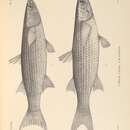Diagnostic Description
provided by Fishbase
Fusiform body (Ref. 51442). Massive head, flattened above the eyes (Ref. 51442). Small mouth (Ref. 51442). Snout short and blunt (Ref. 51442). Two dorsal fins well-separated, the first with 4 to 5 spines (Ref. 40476, Ref. 51442). Pectoral fins are placed high on the flanks (Ref. 51442). Large scales (Ref. 51442). Dorsal sides and flanks gray-colored, ventral side white (Ref. 51442).
Diseases and Parasites
provided by Fishbase
Heterophyes Infection. Parasitic infestations (protozoa, worms, etc.)
Diseases and Parasites
provided by Fishbase
Epitheliocystis. Bacterial diseases
Life Cycle
provided by Fishbase
Spawning takes place at sea near the coast by gathering in groups between September and February (Ref. 51442). The eggs develop at sea (Ref. 51442). The juveniles then colonize the littoral zone and the estuaries (Ref. 51442). Adults enter the lower parts of the rivers and treturn to the sea to spawn (Ref. 51442).
Migration
provided by Fishbase
Catadromous. Migrating from freshwater to the sea to spawn, e.g., European eels. Subdivision of diadromous. Migrations should be cyclical and predictable and cover more than 100 km.
Morphology
provided by Fishbase
Dorsal spines (total): 4 - 5; Dorsal soft rays (total): 7 - 10; Analspines: 3; Analsoft rays: 8 - 9
Trophic Strategy
provided by Fishbase
Migratory species (Ref. 51442). The eggs develop in the sea and juveniles colonize the littoral zone and estuaries (Ref. 51442). The adults enter the lower parts of the rivers (Ref. 51442). They live usually inshore, entering lagoons and estuaries and rivers between temperatures 8-24°C. Feed on epiphytic algae, detritus and small benthic or planktonic organisms, pelagic eggs and larvae. Omnivorous fish feeding on the nutrients, animals and plants on the surface of the bottom or rocks (Ref. 51442).
Biology
provided by Fishbase
Adults are pelagic occurring near shore, entering lagoons and lower reaches of rivers in schools; often in polluted waters (Ref. 51442, 59043) between temperatures 8-24°C. Juveniles colonize the littoral zone and estuaries (Ref. 51442). Adults feed on epiphytic algae, detritus and small benthic or planktonic organisms, pelagic eggs and larvae while juveniles feed on zooplankton until about 3.0 cm SL, then on benthic animals and plants (Ref. 59043). Spawning takes place at sea near the coast between September and February (Ref. 30578, 51442). Oviparous, eggs are pelagic and non-adhesive (Ref. 205). Adults undergo migrations (Ref. 51442).
Importance
provided by Fishbase
fisheries: commercial; aquaculture: commercial; gamefish: yes
Thinlip mullet
provided by wikipedia EN
The thinlip mullet (Chelon ramada) is a species of fish in the family Mugilidae. It is found in shallow European waters and is a migratory species.
Description
The thin lip mullet has an elongate body compressed laterally. The head is short and flattened and the mouth is broad with a narrow upper lip and no tubercles. There are two dorsal fins. It is steely blue above and paler beneath. The scales are large and there is no externally visible lateral line.[4]
Its maximum length is around 70 cm, with the common specimen being around 35 cm. The largest specimens recorded weighed over three kilograms.[5]
Spawning takes place at sea, near the coast between September and February.
Distribution
The thinlip mullet is found in the eastern Atlantic Ocean from Cape Verde and Senegal north to the Baltic Sea. It is also found in the Mediterranean Sea, Black Sea and Azov Sea.[2]
It is a pelagic species, usually occurring inshore, entering lagoons and estuaries, and rivers. It feeds on epiphytic algae, detritus, and small benthic or planktonic organisms. It is common between 0-10m, rarely deeper than that.
Fishing
Thinlip mullet is commercially caught mainly with gill nets, trammel nets, beach seines and sometimes cast nets. In recreational fishing, spearguns and rods and reels with floats are used. Hooks are baited with bread, various pastes, fish guts and similar baits. One must be careful when pulling and reeling in larger mullets since hooks can sometimes hook only soft lips and catch can be easily lost.
Cuisine
Meat is white, tender and very soft. Since Thinlip mullet can be found in polluted waters too, taste and quality of the meat vary. Specimen caught in clear waters have great taste and can be prepared in many ways. It is the best barbecued with some olive oil and lemon juice and as part of mixed fish stew with boiled potatoes and/or polenta.
References

- license
- cc-by-sa-3.0
- copyright
- Wikipedia authors and editors
Thinlip mullet: Brief Summary
provided by wikipedia EN
The thinlip mullet (Chelon ramada) is a species of fish in the family Mugilidae. It is found in shallow European waters and is a migratory species.
- license
- cc-by-sa-3.0
- copyright
- Wikipedia authors and editors

